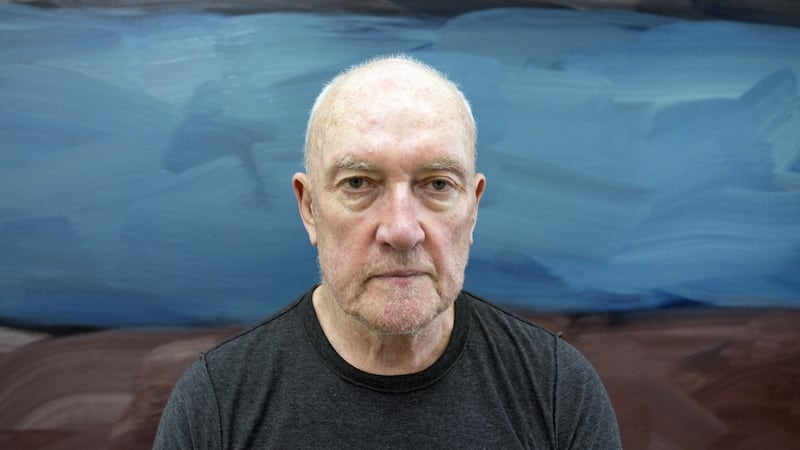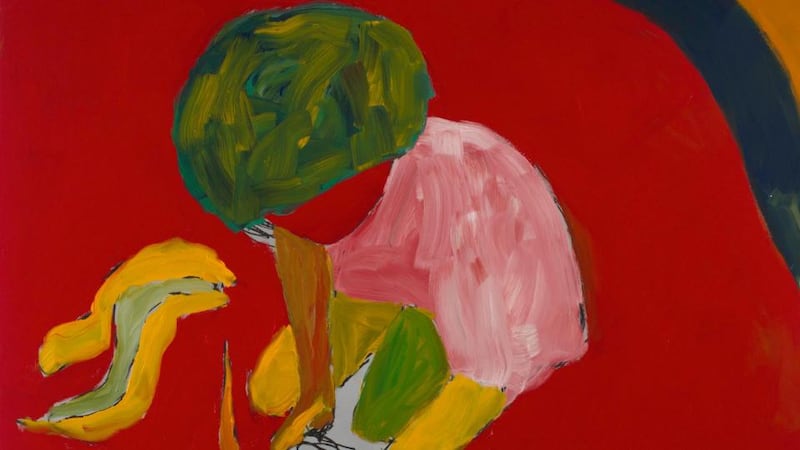A couple of years back David Hockney, while gearing up for a major exhibition of new work in London, remarked in an interview: "The Chinese have a saying – 'painting is an old man's art'." He was 78 at the time and it seemed as if he had never been busier and more productive. He had no intention of giving up working so long as he was able to. At 73, Sean Scully echoes his sentiments. He might think about retiring, he says, in about 20 years. But at the moment, he has never been busier, never more in demand, with exhibitions in Washington, Dublin, the Yorkshire Sculpture Park (Inside Outside, sculpture and painting, until January 6th), Arles (photographs), and many more pending, including shows in Vienna and at London's National Gallery next year.
If he finds it all tiring, Scully doesn’t show it. He maintains his characteristic droll, quizzical manner, easy but alert, taking on the world at his own pace. He admits to being a bit surprised that his stature has not just endured but grown exponentially. “I think it’s a question of the way the cultural ocean moves,” he explains. “Painting has made a huge comeback. There’s a whole generation of curators out there who are young, but they’re sick and tired of conceptual art, they’re interested in things that are actually made. So all over, in South America, in China, there’s a return to a world of emotional materiality in painting. In a way I was waiting for this to happen for a long time, but no longer.”
He will be in Ireland for the opening of an exhibition of his recent work at the Kerlin Gallery. While here, he is making a gift of two sizeable paintings from his Landlines series, one each to the Hugh Lane and the National Gallery of Ireland. There's a room given over to his work in the Hugh Lane and he is keen, as he says: "To reinvigorate it. Before people get tired of it, before I get tired of it and most of all before Barbara [Dawson, the Hugh Lane's director] gets tired of it." As for the National Gallery: "They wanted one, but they couldn't afford one, so it came down to me asking myself whether I would give them one, and I decided I would, I'm happy to."

While he's made his reputation as an abstract painter – stripes and blocks of colour, mostly muted but sometimes boldly vibrant – there have been two departures recently in his work. One is his increasing interest in making sculpture. Inside Outside includes a monumental new stone work, Wall Dale Cubed, utilising 1,000 tonnes of local stone. As with his stone sculpture at the University of Limerick – "the one that kicked off the whole thing" – the wall is solid stone, so that when you are looking at the outside you can "feel the inside without being able to see it ". On the other hand, Crate of Air and its companion pieces, constructed in Corten steel, are "boxes of air".
The other departure, probably more surprising, is a series of paintings derived from photographs of his young son, Oisín, playing on the beach on Eleuthera Island in the Bahamas. In these paintings, it’s as if the bands of colour have departed from their right-angled axes and wrap themselves protectively around the child, who plays obliviously and contentedly in the world of his own imagination. They are also chromatically bright and upbeat.
Memory of minimalism
As Scully says, he was never into the cerebral coolness of minimal or theoretical abstraction. "I haven't wasted a minute of my life reading one of those tedious books on postmodernism". His paintings, while abstract, intuitively reflect his experience and feelings rather than any theoretical position, and he sees them as invested with numerous cultural references. "Take my Landline paintings," he says, which are composed simply of horizontal swathes of colour and tone. "They obviously refer to landscape." Their bands or strata could be read as combinations of land-sea-sky-land-land-sky and so on. "And they're abstract, with a faint memory of minimalism, but they have a rhythm and spaciousness that differs from minimalism."
They are also painted on metal, a hard, “unsentimental” surface that he sees as a corrective to the potentially deep romanticism of the landscape image. This idea, of divergent tendencies and qualities dynamically poised on one surface, he regards as central to his work. “Take the way I work on more than one series at a time. I mean, I don’t like this idea that you should hammer away at one strand of thought until it’s exhausted, and you’re exhausted. I like cross-fertilisation. I’m like a farmer, managing crop rotation. And when I switch from one series to another, there’s a new energy, new colour, I see different possibilities, different ways to make colour, to make colour that is different from other things in the world, which is really the basis of what I do. I was doing an interview with a curator and he asked me to sum up art in one word. Before he even finished asking the question I said: Impurity. Because that’s it.”
From the first phase of Cubism to the 1930s, Picasso’s work changed and developed at a rate that left observers incapable of keeping up. This rate of change was driven, or enabled, by the liberating effect of underlying Cubist ideas. While people were still criticizing and debating his recent work, he had already moved on, his interest was elsewhere. It was something he noticed and learned from, consciously adopting it as a strategy for the rest of his life. Or, as sports people put it: always focus on the next contest.
Scully's recent work, in all its flagrant impurity, does something similar. His Doric paintings are sternly, classically architectonic in form; the Landlines open out into the territory of landscape; his steel sculptures translate the template of his Wall of Light paintings into three dimensions ("It's like painting stepping off the wall, providing a conclusion that was lacking"); the Eleuthera paintings place the human figure at the heart of a previously abstract syntax.

The latter are partly to do with how becoming a parent changes people: "It changes your priorities, it changes everything." He is currently working on another figurative series, Madonna and Child, which draws in Oisín's mother, the painter Liliane Tomasko, "because that's really the relationship that is fundamental to human existence". His Landlines he sees as his "most holistic work since the 1970s. If you stand over on the edge of the west coast of Ireland and look west, you are looking at something you can't see, only imagine. You know America is there and you can imagine it being there. But you're also looking into infinity, because you can see nothing."
‘Awkward customer’
He will show some Landline paintings next year at the National Gallery, London. The installation will include an exceptionally spare painting by Turner, The Evening Star. A single, horizontal division, the horizon line, dominates the possibly unfinished work. Its title was applied later, taken from some lines of verse he wrote in a sketchbook. As it happens, a boy with a shrimping net, accompanied by a dog, is just visible in the foreground.
It is, Scully says, “quite an austere study. I wasn’t obliged to put in a Turner or any other work from the collection, but I wanted to. Also he was a slightly rough guy, like me, a bit of an awkward customer. And his father was a barber, like mine – the Clonmel barber”.
He’s written about the influence of early, menial jobs on his work. “It’s about stacking, putting things in order”. In a cardboard box factory he loaded bales of flat corrugated cardboard boxes into a van. “They were really beautiful, the lines made by the boxes.” He sees his painting as grounded in such experiences and hence widely accessible. “It’s very simple, really.” And he engages with anyone who wants to talk to him. He is against the notion that his art is directed at a select audience, and willing to explain why that is so, by talking and writing about the work.
For most of the summer he was working at his studio in Germany, “in the forest, in Bavaria. I’d never give it up. In fact we were talking about maybe looking at Oisín going to school there. I’m very disturbed by the gun situation here [in the US]. It’s awful at the moment. It’s like a country at war with itself. Polarised. There’s a self-destructiveness to it that’s coming out in all sorts of nasty ways. Everything is seen in terms of oppositions. There’s no middle ground. But the middle ground is where everything happens. It’s where things actually come together, and that’s what my work has been about since the 1980s, things coming together.”
Suzanne Lynch in Washington adds
Amidst the many museums and monuments that line Washington's stately National Mall, the cylindrical, postmodernist Hirshhorn Museum stands out.
The 1974 building was established as the nation's museum of modern and contemporary art and remains one of America's leading museums.
More than 20 years after it held a mid-career retrospective of Sean Scully's work, the Hirshhorn is hosting a new exhibition of Scully's 'Landline' series. The show runs until February, before moving to the Wadsworth Atheneum in Connecticut.
Based around Scully's Landline paintings that featured at the Venice Biennale in 2015, the exhibition also includes almost two dozen works never before seen in public.
Walking along the curved exhibition space, curator Stéphane Aquin explains the impulse behind the exhibition. Why a Scully exhibition; why now? "Actually, it was simple," he says, "It's a great series, an important series by an artist at a key moment in his career."
The museum already owns some Scully pieces, and Aquin worked closely with the artist in New York to select the pieces for the exhibition. As well as dozens of paintings, the exhibition also includes sculptures and photographic material.
Scully's familiar horizontal bands of colour are enhanced by the gallery's idiosyncratic circular space. Tracing the trajectory of the exhibition space it is as if each painting appears on the horizon before disappearing again – a fitting experiential phenomenon for a series that explores the divisions between land sea and sky.
Scully's personal journey from Europe to America is to the forefront in this exhibition as it explores the role of the sea in his work. His own words are carried on the exhibition wall. "One day I was standing off Ireland, on the edge of Aran Island, looking out. Next stop, America…"
But mostly the exhibition shows how he played with the concept of horizons in his recent works, not only in his paintings but in his sculptures, which he calls 'stacks.' "What would the painting be if it jumped off the wall and stood?" he asks in one of the short videos accompanying some of the works.
Ultimately the exhibition shows an artist who continues to revisit motifs and themes, and despite a consistency of subject is always reinventing.
As Scully explains in an interview in the companion volume to the exhibition. "It's never the same. It can never be the same. And that is the beautiful thing about painting – that it can never be the same."
Sean Scully, THE LAND/THE LINE is at the Kerlin Gallery, Anne's Lane, South Anne St, Dublin, October 5th to November 17th (kerlingallery.com)













